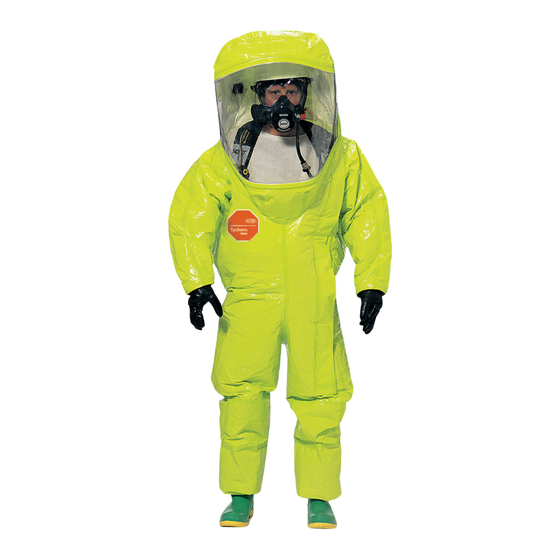Dupont Tychem Vapor Manual del usuario - Página 14
Navegue en línea o descargue pdf Manual del usuario para Equipos de seguridad Dupont Tychem Vapor. Dupont Tychem Vapor 20 páginas. Garments

User Manual for DuPont
Glossary
Air-Inflation Test – A procedure in which a Level A garment
is tested for gas-tight integrity. The test involves blocking off
the exhaust valves, inflating the suit to a specified internal
pressure and monitoring the drop in pressure over a set
time period. The most common method used in the United
States, ASTM F1052, allows a 20% pressure drop after 4
minutes. The air-inflation test is used to determine if a Level
A garment has a leak.
APR (Air Purifying Respirator) – A respirator with an air-
purifying filter, cartridge, or canister that removes specific
air contaminants by passing ambient air through the air-
purifying element (per
www.osha.gov
Also see PAPR or Powered Air-Purifying Respirator.
ASTM – Originally known as the American Society for
Testing and Materials, ASTM International is one of the
largest voluntary standards development organizations
in the world. ASTM Committee F23 on Protective Clothing
and Equipment is responsible for many of the test methods
used to evaluate the performance of protective clothing
for protection against chemical, biological, physical, and
radioactive hazards.
CBRN – (Chemical, Biological, Radiological and Nuclear)
– Abbreviation for the hazards represented by terrorism
weapons. Also seen as CBRNe where the "e" indicates
explosives.
Certification – The process in which products are certified
by an independent company as meeting the requirements
set forth in specific performance standards. These
performance standards are published by standards setting
bodies such as ASTM, CEN, ISO, and NFPA. For 3rd party
certification, the certification company is hired by the
manufacturer to independently test the products and verify
compliance with all requirements of the standard(s).
14
Tychem
Encapsulated Level A and Encapsulated Level B Suits
™
®
section 1910.134(b)).
CFR (Code of Federal Regulations) – The published
regulations of the executive departments and agencies of
the United States Federal Government. The notations "29
CFR 1910.1200" refer to a specific regulations (.1200 – Blood-
borne Pathogen) for a specific section (1910 – General
Industry) of a specific federal agency (29- Occupational
Safety and Health) of the United States Code of Federal
Regulations.
Cryogenic Chemical – A chemical having a boiling point
below -130 °F (-90 °C) at atmospheric pressure (per NFPA
1991). Also see Liquefied Gas.
Doffing – The act of removing a garment from one's body.
Donning – The act of putting a garment on one's body.
Encapsulating Garment – For chemical protective garments,
a garment that provides protection to the torso, head,
arms, legs, and completely covers the wearer's breathing
apparatus.
Exhaust Valve – For chemical protective garments, a device
that releases air from inside an encapsulating garment
while preventing inward leakage of external vapors, liquids
or particles into the garment.
Exhaust Valve Diaphragm – A molded elastomeric disk
which is a key component of an exhaust valve. The
diaphragm blocks the flow of contaminates into the
garment, but when actuated allows excess pressure inside
the suit to vent to the outside environment.
Heat Stress – A serious human health condition caused by
increased core body temperature. Heat stress can lead to
permanent injury and death.
Hot Zone – Term used to describe the area around a
hazardous material release that requires the highest level of
chemical protection.
Inflation Test – See air-inflation test
